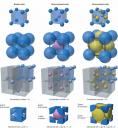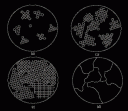 Doc Brown ~
Doc Brown ~
I ran across your column in my quest to find out more about bicycle frame materials (aluminum, steel, titanium, carbon fiber) on a molecular level. I am a 7th grade teacher and i am putting together a unit about the Science of Cycling. I want my students to understand why these different materials have the properties they do on a molecular level. Why is titanium so strong? Is it that all of the particles are so clumped together? I dont know if that makes complete sense but i am trying to grasp why these materials have these certain characteristics and if we looked at a particle level, what would it look like?
Can you help me??
Thanks!
 Metallic Atomic Structure:
Metallic Atomic Structure:
All metals have a crystalline structure made up of «close packed» atoms. The atomic nuclei are in fixed positions while the electrons can migrate. This gives metals their ability to conduct heat and electricity well. The crystal arrangements are better represented by spheres in what’s called a unit cell. There are three main types of packing in the transition metals: Face-Centred Cubic (FCC), Body-Centred Cubic (BCC) and Hexagonal Close Packed (HCP). The packing densities of BCC, FCC and HCP structures are 68, 74 and 74% respectively. The size of the nuclei vary according to the type of element.
 Metallic Microstructure:
Metallic Microstructure:
The atoms in a metallic solid are arranged in close packed crystalline arrangements. However, during solidifaction of a molten metal, different regions are forced to crystallise at the same time. This gives rise to various «grains». Within each grain, the atoms are arranged regularly; it is the spatial orientation of this ordered array that differs between these grains. The sizes of grains normally vary from microns to inches. Grains can be seen with the naked eye in galvanized metal sheet (zinc plated steel), but they are usually microscopic. Generally speaking, the faster the cooling process, the smaller the grain size. Grains are also highly dependent on the forming processes involved in manufacturing a metal. A smaller grain size increases strength on the premise that it is difficult for dislocations to cross grain boundaries. [Read more →]
Tags: Learning Curve, Science Simplified by Dr. Leslie Brown
No Comments »
 I recently purchased a pair of FSA K-force dual pivot brake calipers. I hadn’t heard much about them and nobody seems to have them… anyway I have been very pleased with their performance over the last few weeks so I decided to write this quick review.
I recently purchased a pair of FSA K-force dual pivot brake calipers. I hadn’t heard much about them and nobody seems to have them… anyway I have been very pleased with their performance over the last few weeks so I decided to write this quick review.  Contrary to what other people have said about FSA products, I think these work brilliantly! I have found that both modulation and power are excellent. They’re on par with another set of highly-rated dual-pivot brake calipers: Mavic SSC. They feel stronger overall than shimano ultegra calipers, possibly due to the I-beam shape of the arms. I can’t be 100% sure of that, because I’ve been testing the new vertebrae ceramic brake housing (also pictured). [Read more →]
Contrary to what other people have said about FSA products, I think these work brilliantly! I have found that both modulation and power are excellent. They’re on par with another set of highly-rated dual-pivot brake calipers: Mavic SSC. They feel stronger overall than shimano ultegra calipers, possibly due to the I-beam shape of the arms. I can’t be 100% sure of that, because I’ve been testing the new vertebrae ceramic brake housing (also pictured). [Read more →]









